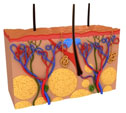
Imagine a patient whose arms are severely burned. Nurses clean his wounds and then wheel over a machine where a laser begins to scan the burn areas.
A computer hums and an inkjet printer starts to quietly whirr back and forth over the wound. With each pass, the appropriate cell types for the depth of the wound are sprayed into the right places. The patient starts to rapidly heal – possibly saving the patient's life and limiting his scars.
What we're painting is the future researchers envision using a technology that is very similar to the inkjet printers you have in your homes.
In mouse trials, the printed skin cells have proven to heal burn wounds quicker than skin grafts, with less scarring.
The treatment works by first harvesting the patient's skin and dissolving it to release individual skin cells. These cells are then grown to large numbers in a lab and suspended in a nutrient-rich liquid.
Each cell type is transferred into separate individual sterile cartridges just as if you were using different colors of ink. Then the computer uses a three dimensional map generated by the laser scan of the wound to guide the printing process.
Experiments have shown that the sprayed cells also worked themselves into neighboring skin so that when the wound healed' the result was more seamless.
This technology is being developed for the US military at the Wake Forest University School of Medicine. Since researchers were successful with mice, they are now testing the technology on pigs.
That's one step away from human trials.
Scientists expect to eventually build commercial skin printers for hospital use. If successful this would be a superior approach compared to current treatment for burn victims who often have to live with disfiguring and painful scars.
More Information
For a video about the exciting new results of research into the use of inkjet printing technology to "print new skin" with excellent images and illustrations go here.
Scientific American is an excellent source of information about scientific discoveries and their article about using desktop injet printer technology to print skin is a great place to get more information.
For more information...
Based on the world's most widely used textbook of medicine — The Merck Manual — but written in everyday language by 300 outstanding contributors. The lay version of the book is provided free of charge on the Internet by Merck & Co., Inc., as a public service. They have a very readable and concise description of the anatomy of skin here. The University of Maryland Medical Center has a similar web site.
Discovery Health has a comprehensive web site about skin, with links to many other skin issues including those associated with adolescence, aging, pregnancy, among many other that provide important an useful information.
For more information...